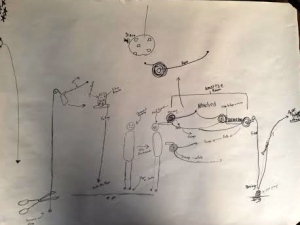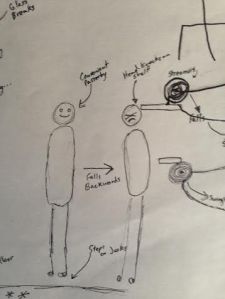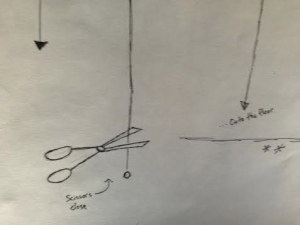Special Services Report
Art Supply/Budget Report
LP 10
LP 9
Reflection week 14
This past week we had a teacher improvement day. I was a bit disappointed at how a fairly large group of teachers talked about their students, as well as how inefficiently the time was used. We were in school for a full day, eight hours, and there were about four hours of actual participation.
One of the exercises was to pick a boy and a girl and write their background, learning style, and an end of the year goal for those students. Most of the specialty teachers, including my co-op, were furious because they only have students six week out of the year and “couldn’t possibly remember their learning styles or think of a goal for them.”
To me, I was reminded of the importance of keeping a relationship with students that isn’t solely based in the classroom. When you are in the halls or visit a regular classroom teacher’s room, an elementary teacher should always find the time and care to value students budding minds as they grow; especially because specialty teachers have the student’s year after year.
On the bright side, I had some really genuine conversations with a few teachers at the meeting. One even stood up to the other teachers complaining about a student and, in a non-threatening way, said; they are just projecting what they’ve been taught. It gave me hope to see that not every older teacher is angry at reform, and that it requires not just an advocacy in younger teachers, but assertion and leadership.
Reading response for week 12
-One of the traditional privileges for teachers in the United States has been control over the curriculum. Unlike most countries in the world, the United States does not have a national curriculum per se, enabling teachers to make curriculum decisions that most benefit local students. However, the Elementary and Secondary Act, also known as the No Child Left Behind Act, has acted as a national curriculum policy by enabling school administrators to conceive of a curriculum that privileges reading and math, and neglects arts programming.
-An effective contemporary leadership vision for art education needs several baseline characteristics. It must characterize knowledge ofthe visual arts as essential to human life. It must take into account the cultural and personal impact of the range of popular and fine art. It must connect the visual arts to a variety of societal aims as well as educational goals.
-Leading as a Form of Social Action:
To teach from a social perspective is to convey the conviction that the visual arts are vital to all social groups. Art education can lead students from personal expression to cultural engagement through the capacity of art to act as a social mediator.
-Forming and Working in Groups:
When working in leadership groups, participants might: (1) develop charges that are the main goals for the group, (2) write some guiding principles based on common interests among members of the group, (3) allocate jobs for each member based on the charge and the guiding principles, (4) ensure that plans are enacted and evaluated, and (5) organize reporting of group accomplishments.
Student service-learning that supports art education can be seen as a way of helping students to understand the communal aspects of art and the necessity of art education. Through service projects, students can take on public roles that illustrate the many benefits of art education by, for example, organizing art experiences that help their community or protect the environment.
Maintaing a Critical Attitude:
Uncovering and challenging taken-for-granted assumptions is of crucial importance for those who lead change. This sometimes requires turning assumptions upside down to find their sources. For example, consider the assumption that art is not basic to education. This assumption is based, in part, on the idea that the visual arts are not essential to contemporary economies. However, the assumption is false. In fact, art is an increasingly important foundation of 21st-century economies, particularly as a result of the expansion of creative industries. Educational leadership should help to refute such misconceptions that diminish the basic quality of arts in human learning.
Staying in Touch with the Field:
General educational policy often seems to move in directions that are contrary to the forward-looking ideas of art educators, so it helps to know the work of leaders who are knowledgeable and committed to art education at the national level.
Reflection week 13
A valuable lesson I learned this week was how all that prattle in our articles throughout the years concerning communicating with classroom teachers is extremely important. I also learned how to better predict every minute detail students need and responses they might have. This past week, I taught a lesson to the kindergarten classes focusing on the idea of pattern. I had done research to get an idea of where most kindergarteners were at with their understanding of the concept.
The project was for students to draw loopy lines from the beginning of their strip of paper to the end of it with 12, 15, or 18 swirls, depending on how large they make them. Students were to alternate three chosen colors of crayon in a consistent pattern to color in the swirls that they had created on their strip of paper. After that, they were to draw on a pair of antennae on one end of the line, stick two sticker eyes onto the same end, mount their work on a piece of pre-cut construction paper and poof! A patterned caterpillar.
When the lesson began for the first class, I had expected that I would have to talk about pattern from the ground up. I was pleased when I a large number of the students knew exactly what I was talking about and even offered examples for AB and ABC patterns. As a result, I still reviewed examples of different ABC pattern types on the dry erase board and did an example caterpillar with them at the front of the class, but a more abridged version than what I was planning on. As a result, about a fourth of the student’s work did not turn out the way I expected. Some of the patterns were AB patterns, some were just scribbles. In the two consecutive classes, I spent more time with examples and instruction of ABC pattern. The confusion went down some, but not much.
What would have helped was for me to talk to their teachers specifically, not just research online. I could have asked how and at what level pattern was being taught in the classroom, how I could most successfully build off of that, and how I could introduce a more elaborate step in pattern making that would effectively lead into its further use in their classroom.
Reading Response for week 11
Surviving in the trenches: A narrative inquiry into queer teachers’ experiences and identity
-Recent polls suggesting that teaching is not an appropriate profession for the queer teachers. To instill heretonormative attributes?
Surviving in the trenches: A narrative inquiry into queer teachers’ experiences and identity
-Reconciling identities as both a teacher and as a member of the LGBTQ community.
-This is partly the result of the implicit expectation that the teacher be asexual (especially in the lower grades), or in the case of queer teachers, that they avoid “acting gay” at all costs so as to prevent oneself from being outed by a colleague, parent or administrator.
-Maintaining the connection between mind and body is more difficult for queer teachers because they are defined by their sexual difference.
Surviving in the trenches: A narrative inquiry into queer teachers’ experiences and identity
-Despite the struggle that teachers may have in coming to terms with disclosing their sexual identity in the classroom, teachers being open about their sexual identity will help students address their homophobia (and perhaps other biases). From a political point of view, teachers being openly out at school forces educational institutions to face the reality that there still exists a great deal of discrimination based on gender and sexuality.
-Perhaps an even greater fear is that of being accused of child abuse.
-More or less, this “hidden” sociopolitical policy influences how gay and lesbian teachers’ construct and maintain their identity in the school context. As John indicated, he is a devoted teacher who just happens to be gay. He avoids jeopardizing his profession by not disclosing who he is, in terms of his sexual orientation, at his school. Furthermore, his status of being a teacher for young children inflicts on him an excessive pressure to not divulge his homosexual identity.
-Although there may be a difference between a first grader’s perception of gender roles and that of a twelfth grader, these stereotypes influence how students perceive gender difference and gender roles in our society. Consequently, even young children are capable of recognizing the “uncommon” characteristics of their teachers, which they have deemed to diverge from the established gender stereotypes.
-”When I first started at my school, my name was written in the girls’ and boys’ restroom stating “Mr. XXX is gay.” There have been several incidents where students have spread rumors about me being gay. One student, who I had in 4th grade, came up to me when she was a fifth grader..She said that a couple of her friends had said I was gay. She was so upset they had been talking about me and saying I was gay. I was totally caught off guard. In retrospect, I should have asked her “Well, what about that makes you so upset?” and held a conversation with her about why this was such a terrible thing to her. But I didn’t, due to my shock.”
-I don’t want to out myself like I have said. Some students have even commented on my sexuality. I always have to tell them that I have a boyfriend to shut them up. I laugh now but really I think it is hard to always lie in a place where you care about the people. It is like I am a caricature of someone, but not me.
Surviving in the trenches: A narrative inquiry into queer teachers’ experiences and identity
-“I am not out, nor do I ever talk about my personal life at school with my students or my colleagues. But, I am not the typical man. My kids see me, the real me, when I am teaching. I make weird voices, dance sometimes, I sing at times, and generally can act pretty silly. Not that these behaviours are necessarily “gay”, but what I am trying to say is that I do not hold back natural personality within my classroom in order to fit some gender stereotypes. I use my own voice in my teaching and do no try to come across as more “masculine” to my kids. As an educator who cannot really discuss homosexual topics in class, I try and beat down the barriers of gender stereotyping within my classroom.”




